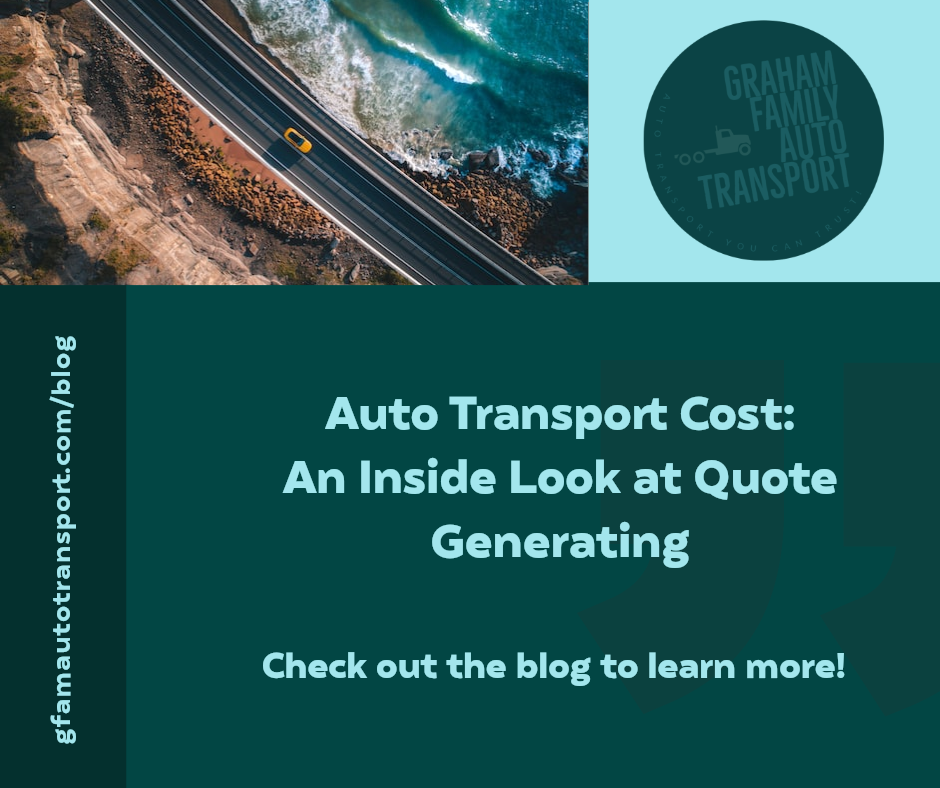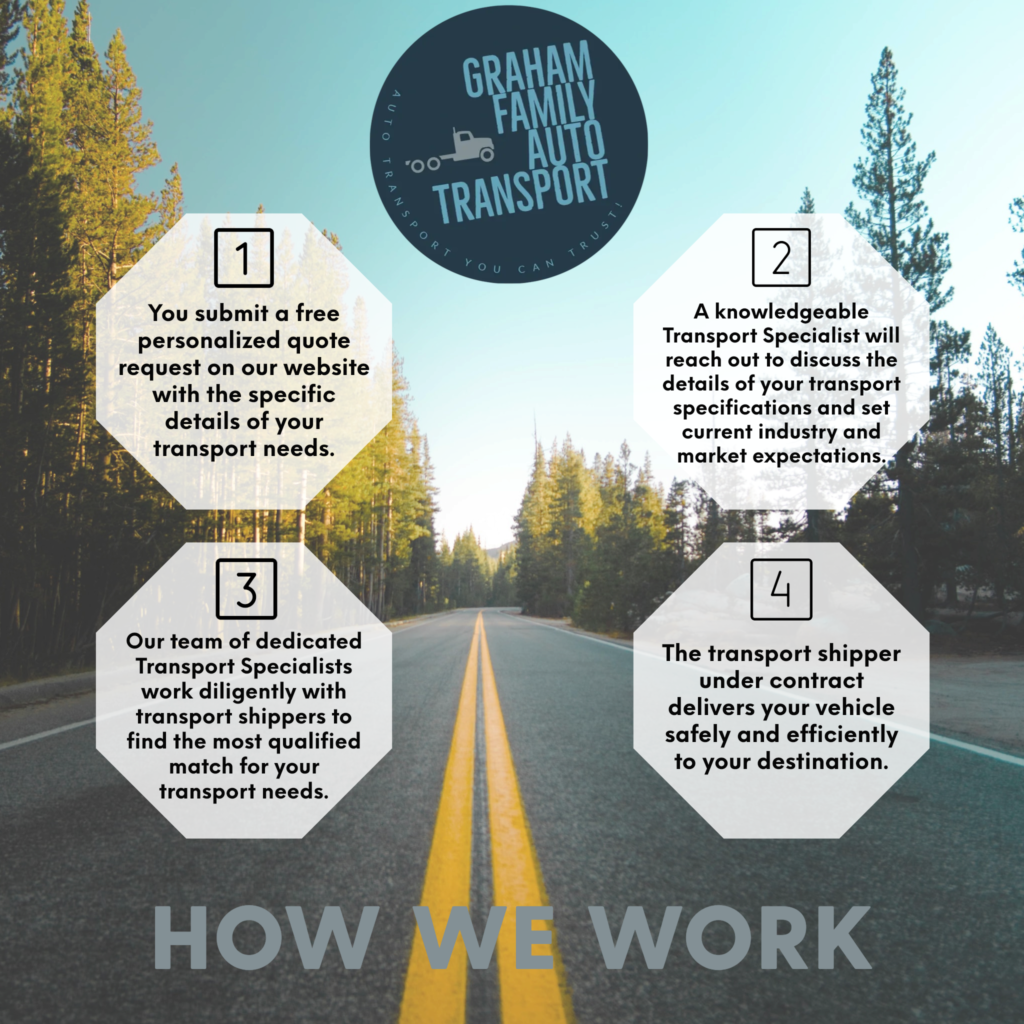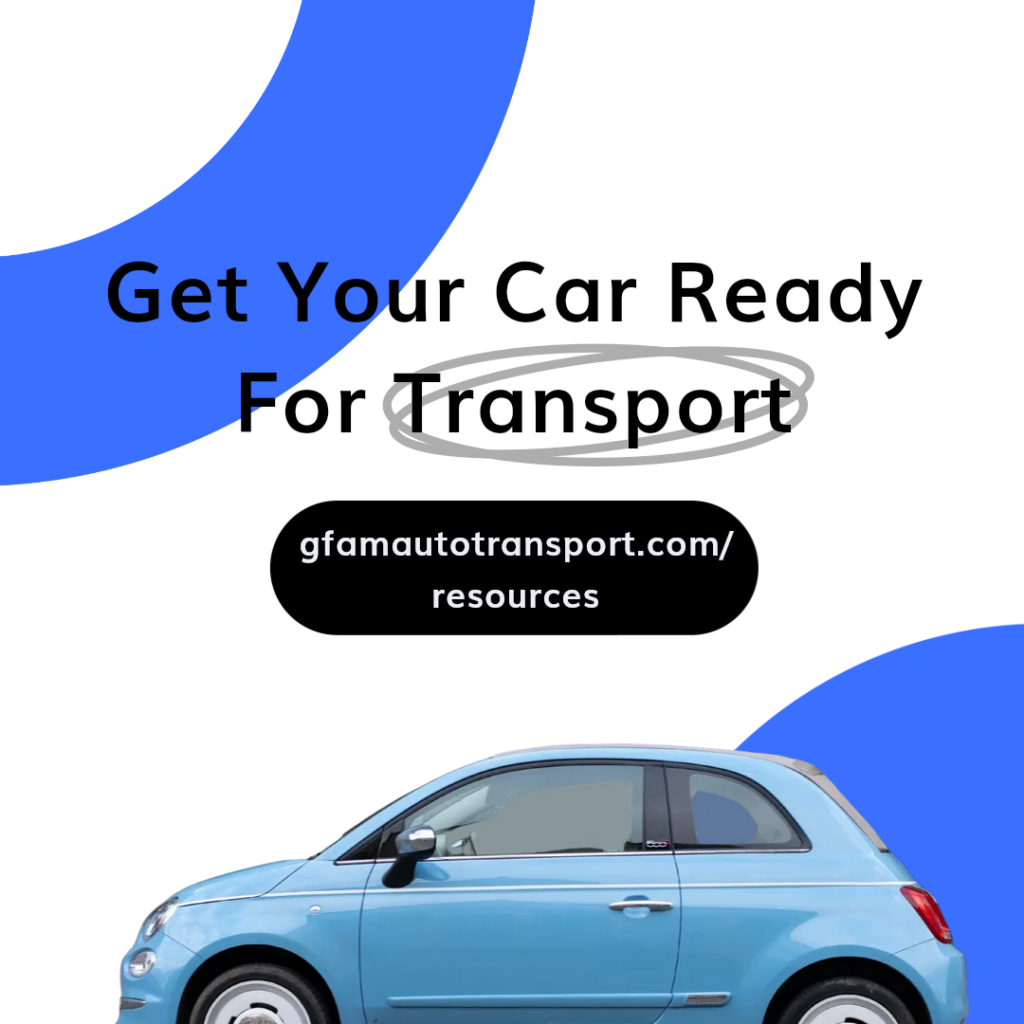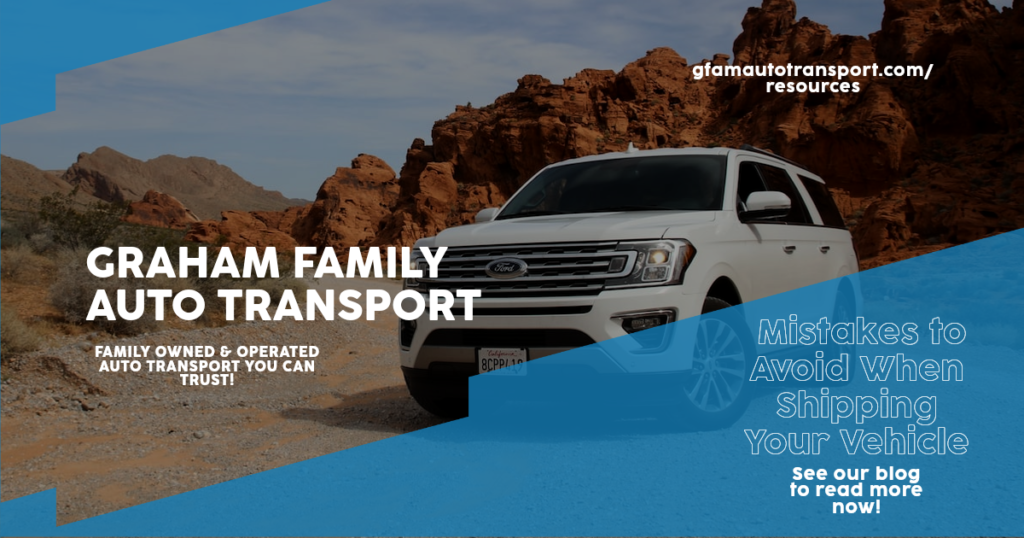Auto Transport Cost: An Inside Look at Quote Generating

Auto transportation services are drastically increasing in popularity in recent years for a number of reasons. Largely due to convenience and cost-effectiveness, many people are taking advantage of car shippers across the country. When the need to move a car from one place to another, utilizing a professional auto transport company is often the best option. However, it is important to understand the costs associated with the entire shipping process before choosing a company to work with. There is never a flat rate price for shipping a vehicle so we feel it’s important to explain the many factors that impact the rate you will pay.
The average cost of transporting a vehicle can vary significantly based on a number of different factors. In general, the distance of the transport from origin of pick up to destination of delivery, vehicle type, the type of transport carrier used, vehicle modifications and specifications, transport route popularity, and seasonal changes such as gas pricing and weather can all impact the cost of shipping a vehicle. For the purpose of this article, the costs and quoting discussed is only in reference to door-to-door services. Some transport services offer terminal-to-terminal services which involve dropping the vehicle off at a designated terminal and then picking it up at another terminal. At Graham Family Auto Transport , we are pleased to provide door-to-door services to our vehicle shippers! Please be advised if you are interested in pursuing terminal-to-terminal shipping that the cost may differ significantly.
Automatic Quoting vs. Personalized Quoting: What’s the difference?
Many auto transport services, ours included, offer online quote requests for inquiring about the pricing of the shipment. Some services offer automatic quoting which will provide a quote immediately whereas others submit your inquiry details to a transport specialist to create a personalized quote by a human. While it is completely understandable to prefer the convenience of an automatic quote, it is highly recommended to speak with a representative before signing any contracts regarding the quote provided. The reasoning for this is that automatic quote generators are not able to look at certain factors of the shipment like a human can. For example, things like car modifications, weather, route popularity, and gas pricing are not usually reviewed when AI (artificial intelligence) quoting systems are utilized. While the quote received may sound better up front, it can often cause havoc on the back end when the time comes to actually book a carrier under contract. Too often, these transports are underquoted which causes issues with booking for two reasons: no carrier is requesting to transport the vehicle because the pricing is too low or carriers are offering to transport the vehicle but requesting additional money.
At Graham Family Auto Transport , we provide personalized auto transport quotes that have been reviewed by a transport specialist to provide the most accurate estimate possible. We are happy to provide the quote details via email if that is the preferred method of communication but highly encourage a telephone conversation at any time to discuss the details, cost, and any questions regarding the quote provided.
Cost: What factors are considered when generating the cost for transport?
There are a number of different factors that are considered when generating a quote for transport. Primarily, the distance of the transport from origin of pick up to destination of delivery, the type of transport carrier used, vehicle type, vehicle modifications and specifications, transport route popularity, transport timeframe, and seasonal changes such as gas pricing and weather can all impact the cost of shipping a vehicle. But why and how do these factors impact the cost of shipment so much? Let’s look at them individually and more in-depth.
- Distance of Transport: The distance of the transport from the origin pick up location to the destination of delivery is one of the first things that will be reviewed when determining the cost of transport. The average cost of transport for standard (not modified) vehicles can range anywhere from $0.58 to $2.92 per mile depending on the mileage of the transport. In general, the greater number of miles for transport, the smaller the cost per mile. While this is not guaranteed and many other details can impact this number, the general rule of thumb places the highest cost per mile for transports under 200 miles and the lowest cost per mile for transports 1500 miles or greater.
- Carrier Type: The “carrier type” refers to the type of transport trailer used to ship the vehicle. There are 2 common carrier types – open and closed trailers.
An open carrier is a type of trailer that is open to the elements. These types of trailers can usually fit more vehicles on the “truck” which ultimately lowers the cost of shipping. On an open carrier, the vehicles are exposed to the weather and share the truck with other vehicles. While damages from the elements can happen, they are rare. Open carrier trailers are the most common type of transport type requested for most vehicles.
A closed carrier (or enclosed carrier) is the exact opposite of an open carrier. The vehicles shipped on an enclosed carrier are housed in a covered truck. Typically, these types of carriers can only transport a handful of vehicles at most which increases the cost of the transport. This type of carrier is most commonly utilized for luxury/exotic vehicles, vehicles with lowered or modified road clearance, or vehicles with other modifications that make a standard open carrier transport problematic.
- Vehicle Type & Modifications: Many vehicles don’t fit the “standard” when it comes to size, weight, and structure. That’s okay! This doesn’t mean the vehicle can not be shipped, it just means close attention should be paid to the type of carrier and the expertise of the transporter when booking. Vehicles that are oversized, have external modifications that increase the dimensions, or vehicles that have internal modifications that increase the weight of the vehicle are common causes for quote variations. Other examples include non-traditional vehicles like fire trucks, snow mobiles, tractors, and food trucks. The size, shape, and weight of the vehicle being transported can directly impact the number of vehicles that can fit on the transport, thus creating the variance in cost.
Additionally, the same idea applies to standard vehicles on a smaller but still valid level. The size and weight of a Honda Fit is going to be significantly different than a Chevy Tahoe! Driver’s have to take things like total weight and available space into account when planning their routes. The size and weight of the vehicle will impact how many vehicles are able to fit on the truck in total.
- Transport Route Popularity: While transport drivers are not usually restricted to specific routes and are typically able to move freely across the states when determining their routes and loads, there are certainly geographical areas and routes that are more prominent than others. For example, transporting a vehicle from New York to Florida or from Florida to California are going to be much more populated by available carriers versus a transport coming out of less traveled locations. Absolutely no disrespect to those Midwest and Intermountain West states but, unfortunately, the number of transports coming out of places like Wyoming, Idaho, or Utah is simply nowhere near their coastal state counterparts. Because of this, drivers will need to be adequately compensated for transports that take them out and away from more populated routes.
- Seasonal Changes: The three primary factors indicated when discussing “seasonal changes” are gas prices, weather, and route popularity changes.
Gas prices are frustrating. They’re variable by state, always changing, and seemingly always rising. Unfortunately, the cost of gas prices is something transport drivers need to monitor closely when determining the cost of transports. It would be extremely easy for the cost of gas to overshadow the price of the transport if not taken into account. More or less, the driver’s would be paying to complete your transport if they failed to take gas prices into account.
Weather, like gas prices, is vastly different depending on the season and geographical location. Weather and seasonal natural disasters like snow, tornadoes, earthquakes and hurricanes present drivers with unique challenges during transport. Driving through areas of the U.S. that are prone to these types of weather can be difficult during their seasons causing cost related changes based on the geographical location and time of year.
Route popularity changes are both geographical and seasonal. Certain societal travel “seasons” can impact things like gas prices and the number of drivers in a particular area. For example, the route from states in the northeast coming down to Florida, and vice versa, becomes increasingly popular twice a year as the snowbirds make their travels to or from the warmth and sunshine Florida has to offer. The beginning and end of the academic year for colleges and universities is another common influx of route popularity in certain areas as many individuals elect to ship their college student’s car instead of making cross-country drives. Knowing these “busy” areas and seasons in the industry is something your auto transport specialist should take into account when scheduling your transport.
- Transport Timeframe: The amount of time provided to the auto transport company from the time of quoting to the time of transport can also impact the pricing. All of the transport carriers are using a central dispatch board to view listings of vehicles needing transport. Ultimately, the most aggressively priced vehicles are going to be selected first for transport. What does this mean, exactly? Well, it means that pricing needs to be aggressive enough to move the vehicle but not too aggressive as to move it too promptly or cost unnecessary money. If the transport timeframe is rushed or limited, it is in the best interest of the transport company to list the vehicle requesting transport aggressively so they are more desirable than the other less aggressively priced vehicles on the listings. This encourages drivers to select that vehicle first and get it moved promptly. If the vehicle requiring transport is not on a specific timeframe, or the timeframe is very far out in the future, it can typically be priced less aggressively as to fall somewhere in the middle of the listings without concern. If a transport is listed at the bottom of the listings or well below the lowest priced transport, the likelihood of the vehicle moving in a timely manner, if it moves for that pricing at all, is significantly diminished. In general, it is recommended to set up a transport approximately 2-3 weeks prior to needing the vehicle moved. Utilizing this timeframe will assist in keeping cost more reasonable and avoiding delays or missed timeframes.
Another thing to consider is that the cost of the transport is all inclusive. This means that it includes payment to the auto transport logistics company, payment to the driver/carrier, and all applicable taxes, tolls, and fees. While the structure of the payments may vary from company to company, the total cost for transport should always cover both the logistics team and the carrier.
Conclusion
At the end of the day, the majority of auto transport logistics companies are brokers and do not own and operate their own trucks for transport. This is normal! It is standard in the industry for a transport company to function as a brokerage who then partners with auto carriers across the nation to provide your transport. Because of this relationship, it is in the best interest of your auto transport company to price your transport appropriately. Typically, the transport company will have a set “broker fee” that comes out of the total cost of the shipment and is paid directly to them. The remaining balance of the transport total is then paid directly to the carrier/driver. This means that whether your car is shipped for $500 or $5,000, the auto transport company is making the same amount of money. They don’t get paid until they move your vehicle so it is definitely in their best interest to price the transport in a way that works for you and for the drivers. Overcharging for your transport does NOT financially benefit the auto transport logistics team in any way and can even make the transport look fake or fraudulent if it is overcharged beyond a certain threshold.
There’s a lot to consider when reviewing the pricing of an auto transport. It’s not mandatory but it can be extremely beneficial to be aware of these variables to ensure you get the best value for your money but also for peace of mind and understanding. Candor and communication are key when discussing transport quotes to ensure proper expectations are provided and result in a stress-free transport. You should never feel concerned about asking for clarification regarding the quote provided for a transport you’re setting up. If the auto transport logistics company is not open to having a cost and pricing discussion then that should be a very big red flag. Never be afraid to shop around or ask questions.
At Graham Family Auto Transport a transport specialist can be reached by phone at (813)488-0970 or email at reservations@gfamautotransport.com. You can also submit an online quote request at our website anytime!
Happy Shipping!
Graham Family Auto Transport








